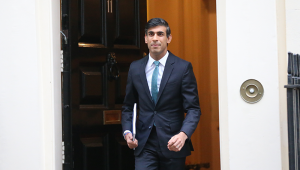25 July 2008
A revision of the sustainable investment rule to allow extra borrowing may diminish New Labour's claims to fiscal responsibility but given the current debt burden, it may be the lesser of two evils
In 1997, Gordon Brown, then chancellor, announced that the Labour government would adhere to two fiscal rules the golden rule and the sustainable investment rule. These were designed to signal that New Labour would manage the country's finances better than the preceding government.
Eleven years on, there are now hints that the sustainable investment rule will be revised. But if a new rule allowing additional borrowing were introduced just as the current rule would have been breached, would the credibility gained from having fiscal rules be undermined?
The sustainable investment rule requires the government to keep the public sector's debt at a 'stable and prudent' level. In the 2003 Budget, Brown stated that in practice this would mean that net debt will be maintained below 40% of gross domestic product in each and every year of the current economic cycle. There was nothing special about the choice of 40%, but compliance would ensure that debt was kept below the level bequeathed by the previous Conservative government.
The latest forecasts for debt published by the Treasury in its March 2008 Budget (see Figure 1) suggested that the outlook for compliance with the rule was extremely tight, with debt forecast to peak at 39.8% of national income in 201011. Economic and policy developments since March have made the short-term outlook for debt worse rather than better, further increasing the possibility that the rule will be breached in the next two to three years. In this context, any reform that facilitated greater borrowing in the short term would be treated with suspicion.
The Treasury, however, is suggesting that a statement first made by Brown in 1999 implied that he always planned to reassess the sustainable investment rule when a new economic cycle was judged to have begun.
One reason to abandon slavish adherence to the rule at this particular moment is that compliance may well require cutting spending or increasing taxes at a time of weak economic performance. Relaxing or breaking the rules would likely come at the cost of further eroding confidence in the government's commitment to fiscal prudence. But given the outlook for the debt burden, this may be the lesser of two evils.
One way the government could have avoided getting into the current situation would have been to plan with a larger margin for error. Forecasting borrowing is inherently uncertain: in the past, the average error in borrowing forecasts one year ahead is 1% of national income (about £14bn).
To give itself a good chance of keeping debt below the 40% ceiling, the Treasury's central forecast for debt ought to have been well below that ceiling. For example, assuming the Treasury is as accurate at forecasting future borrowing as it has been in the past, if the central forecast had been 35% of national income four years ahead, then it would actually have had a three-in-four chance of keeping debt below 40%. Unfortunately, this practice has not been followed in recent years.
However, the operation of the rule could be improved. For example, while judging the rule against a standardised definition of public sector net debt has the advantage of transparency, it also has the disadvantage of failing to reflect fully the total liabilities of the state.
Including other liabilities such as unfunded public-sector pensions or the future payments inherent in Private Finance Initiative contracts alongside a commensurately higher debt ceiling, might give a fuller picture of the true sustainability of public liabilities but these measures have their own drawbacks. At the very least, these liabilities should be considered alongside the measure of public sector net debt currently used.
Furthermore, ensuring forecasts for debt are as transparent as possible (perhaps going as far as the independent fiscal policy committee proposed by the Conservatives) might help retrospectively to distinguish unexpected bad news from previous optimism. Such improvements would deliver some benefits.
But whether the government could implement reforms that facilitated greater borrowing without losing credibility in its commitment to maintain sound public finances is unlikely.
Carl Emmerson and Gemma Tetlow are, respectively, deputy director and senior research economist at the Institute for Fiscal Studies
PFjul2008



















